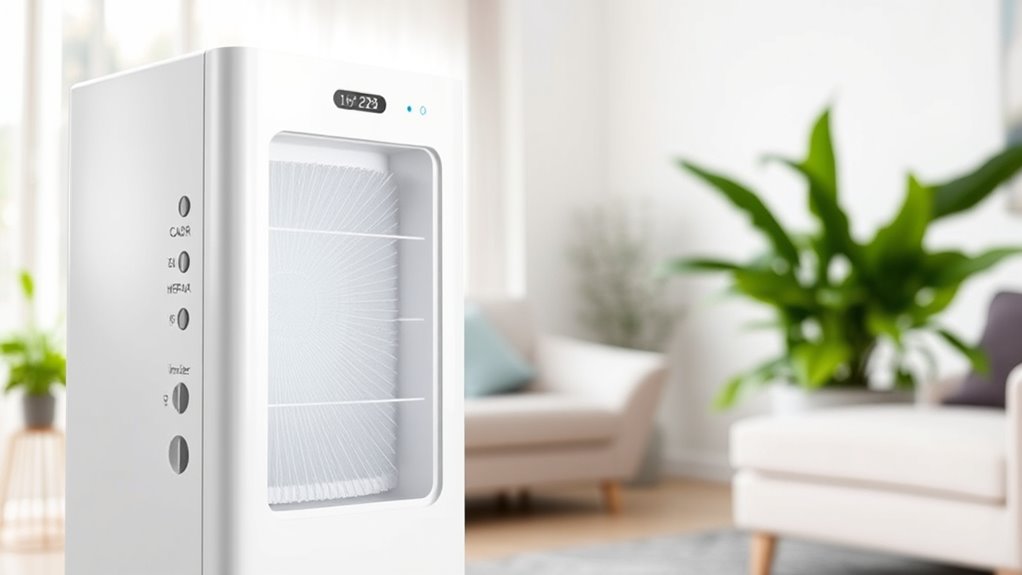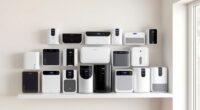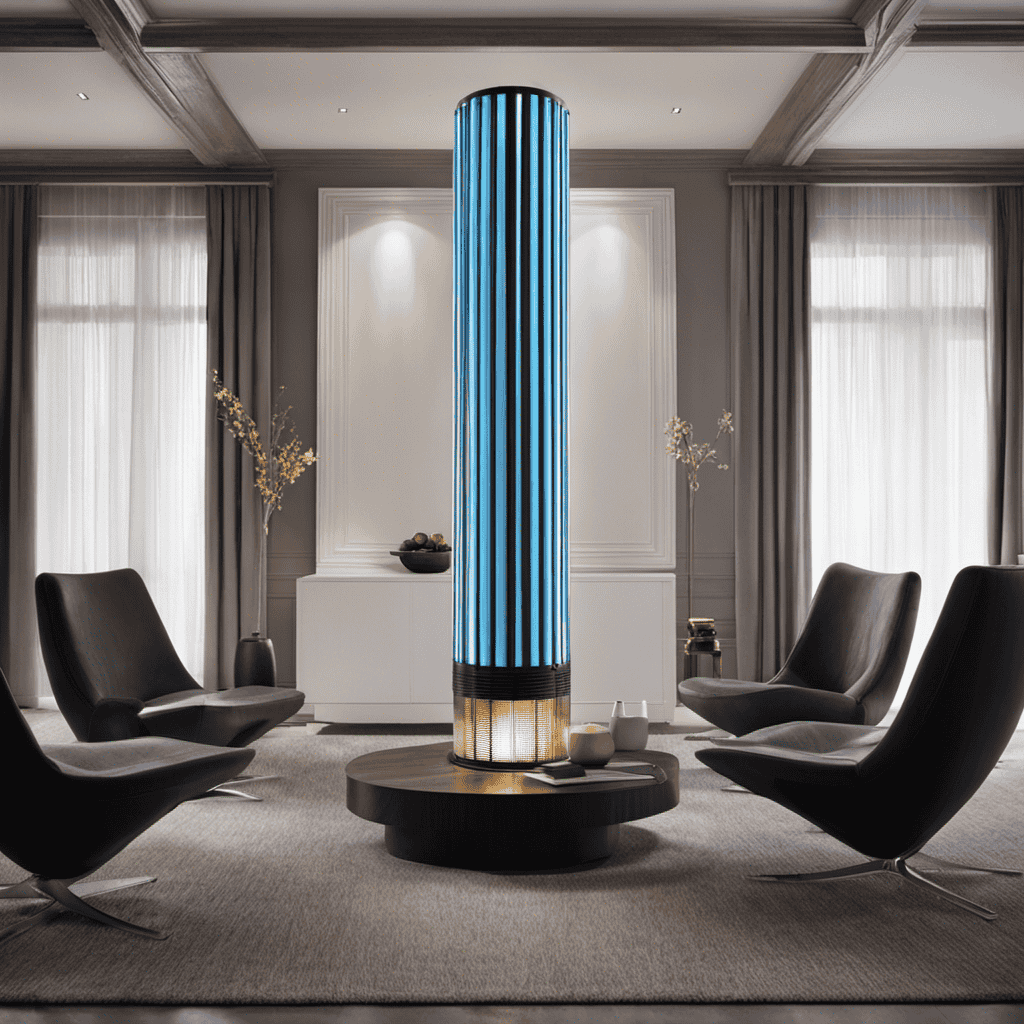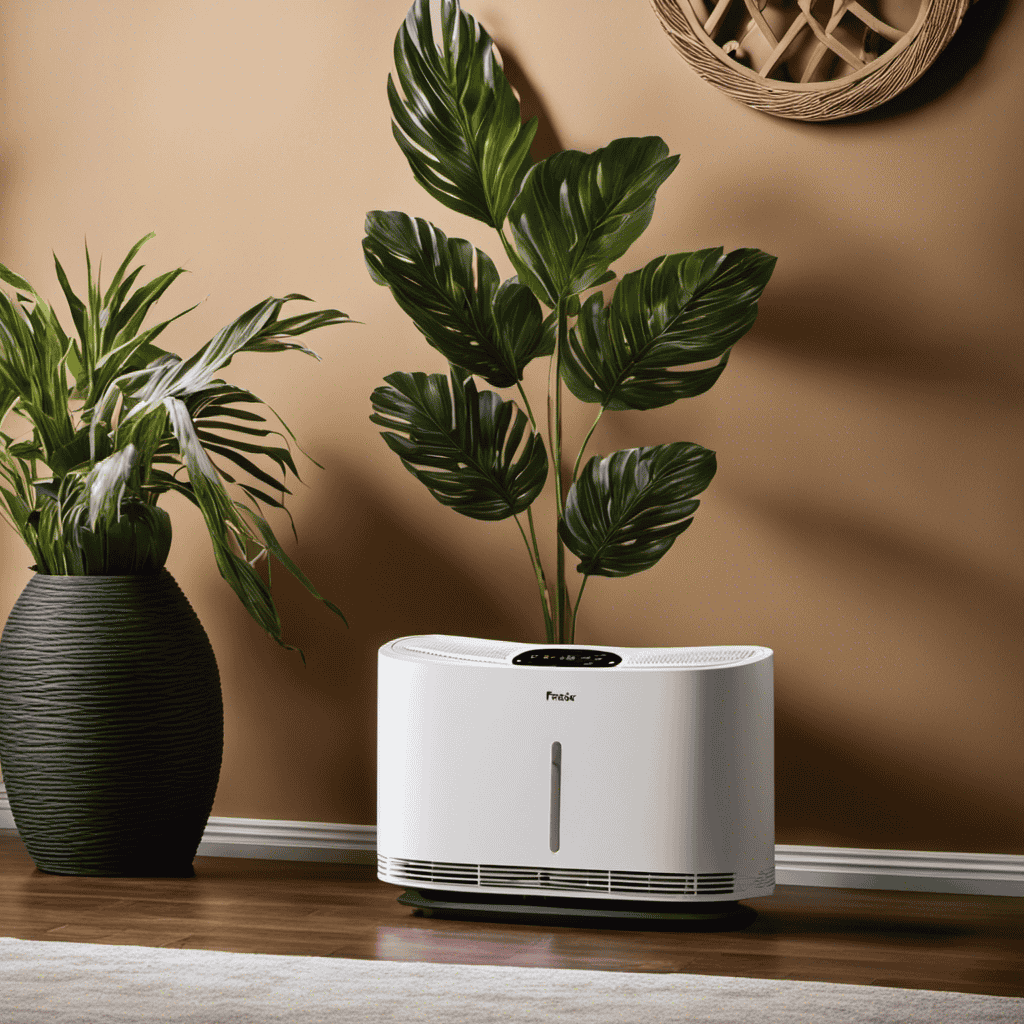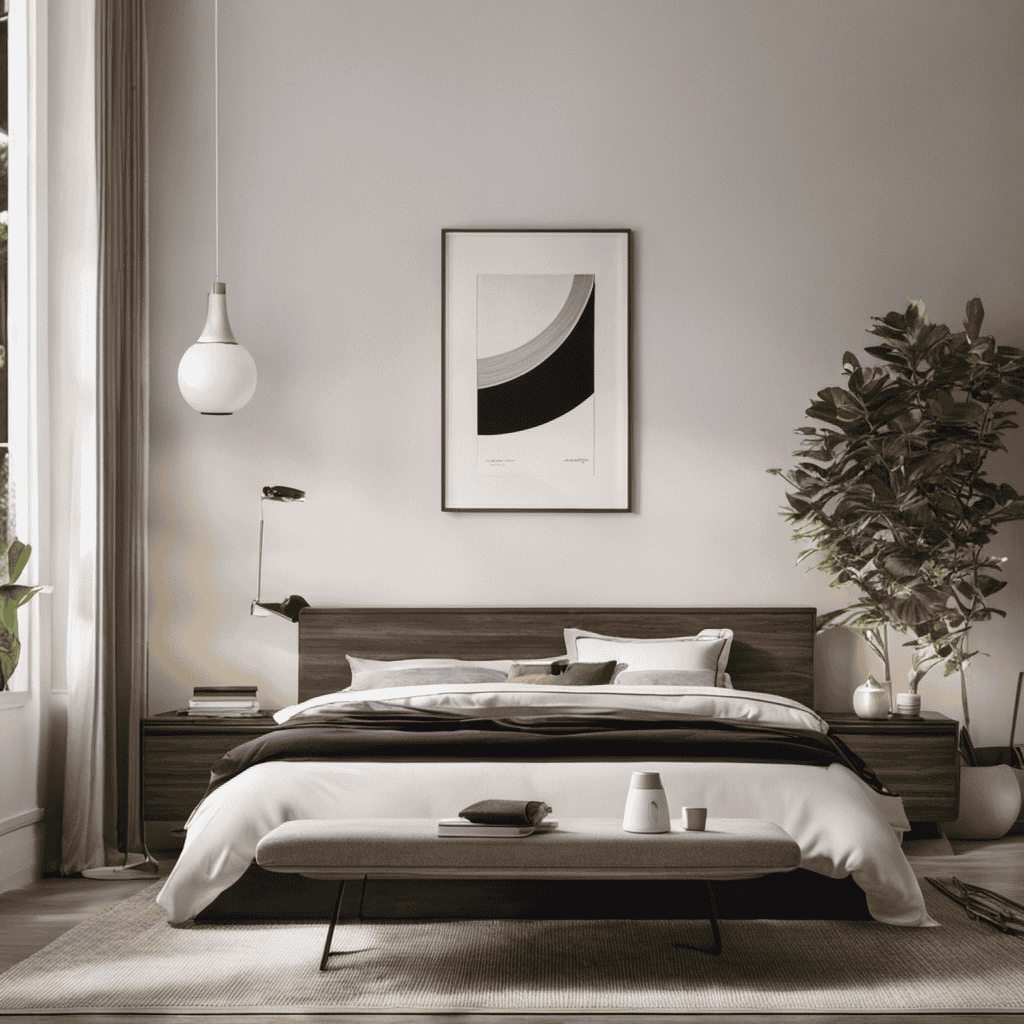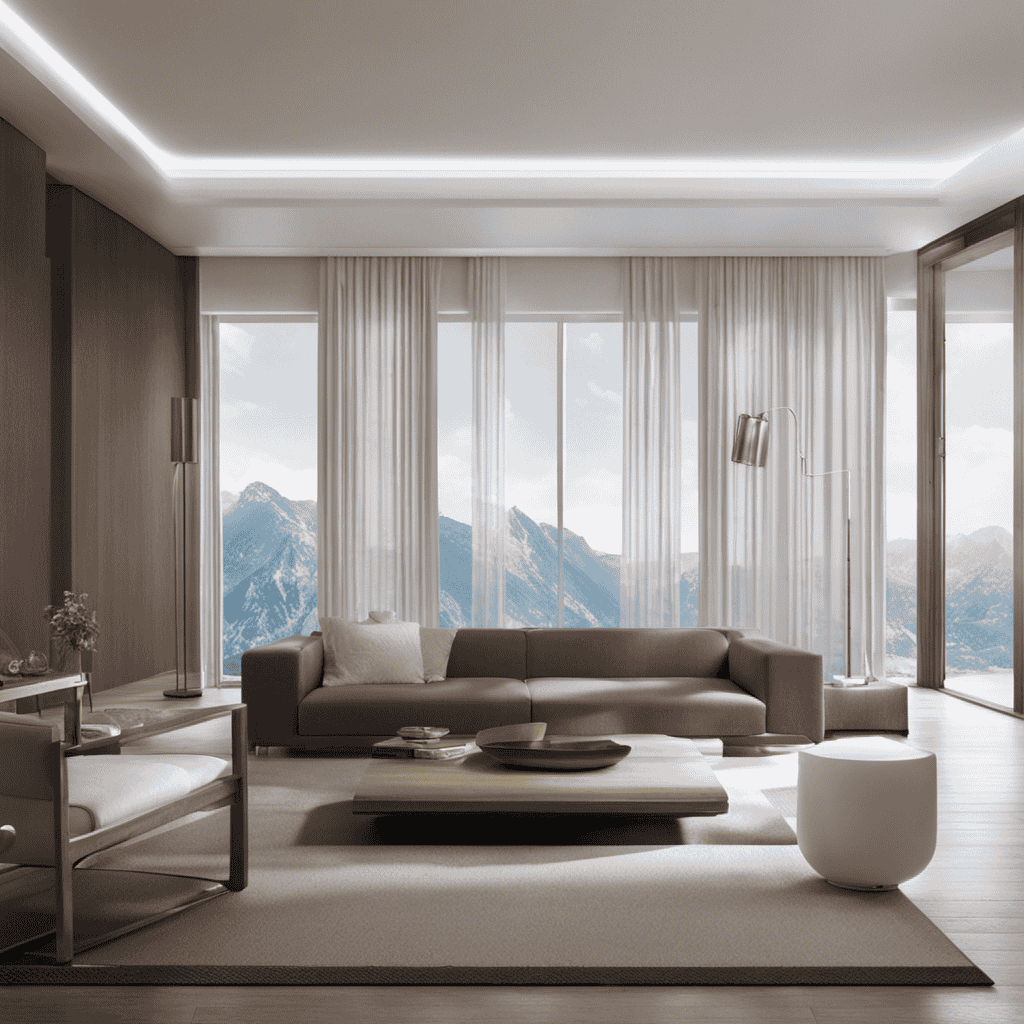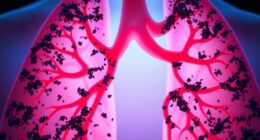Understanding air purifier features helps you pick the right device for cleaner air. HEPA filters trap tiny particles like dust, pollen, and bacteria, while CADR ratings show how quickly the purifier can clean your space—higher is faster. Ionizers release negative ions that help particles settle or stick together, but they work best with other filters. Additional features like air quality sensors and smart controls can enhance performance. Keep exploring to find out how these features work together for your needs.
Key Takeaways
- HEPA filters trap particles as small as 0.3 microns, effectively capturing dust, pollen, and bacteria.
- CADR measures how quickly an air purifier filters pollutants; higher CADR means faster air cleaning.
- Ionizers emit negative ions that attach to particles, aiding in their removal but should be combined with filtration.
- Additional features like air quality sensors and smart controls optimize performance and user convenience.
- Select features based on specific pollutants, maintenance needs, and environmental conditions for effective air purification.
How HEPA Filters Capture Particles and Improve Air Quality
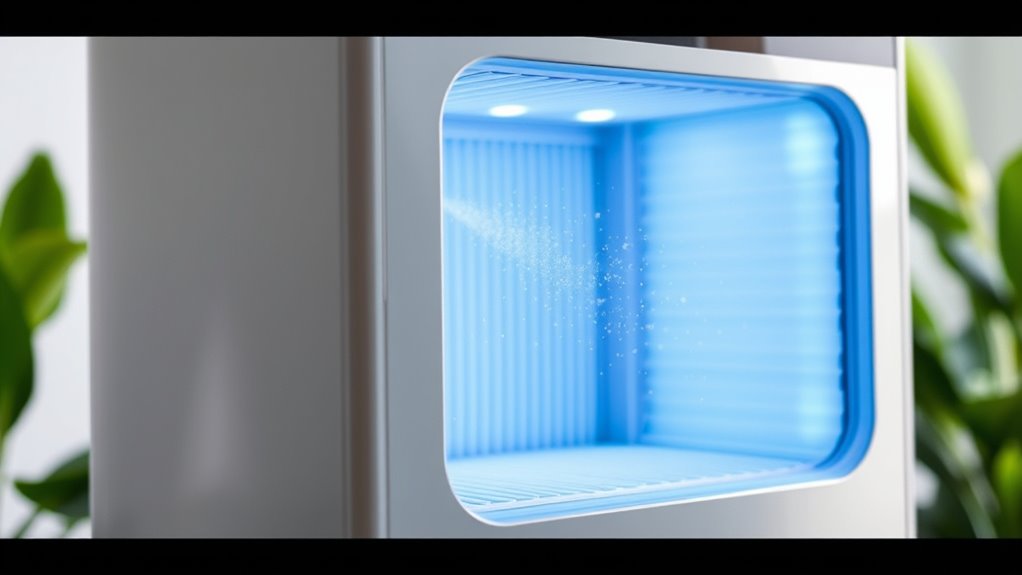
HEPA filters are highly effective at capturing tiny airborne particles, which considerably boosts air quality. Their high HEPA efficiency means they can trap particles as small as 0.3 microns, including dust, pollen, pet dander, and some bacteria. This level of particle removal significantly reduces allergens and airborne pollutants in your environment. When air passes through the filter, the fibers create a complex maze that forces particles to collide and stick, preventing them from circulating back into the air. As a result, HEPA filters maintain cleaner, healthier indoor air. Their ability to efficiently target even microscopic particles makes them a crucial feature for improving air quality, especially in homes with allergy sufferers or respiratory issues. Ensuring your purifier uses a true HEPA filter maximizes its particle removal capabilities. HEPA filtration technology is continually advancing to improve efficiency and lifespan.
Understanding Clean Air Delivery Rate (CADR) and Its Significance
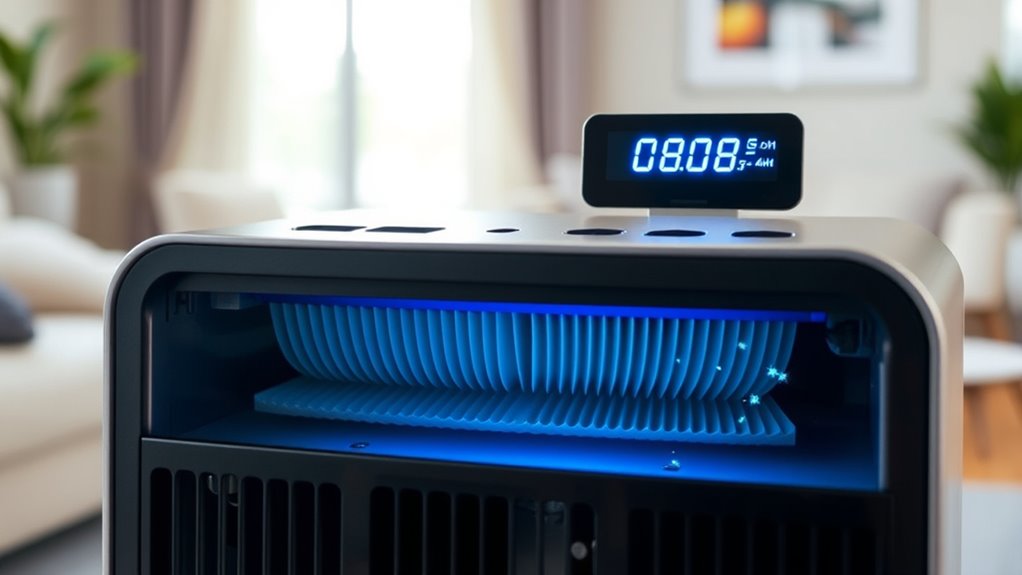
While HEPA filters effectively trap microscopic particles, understanding how an air purifier’s overall performance is measured can help you choose the right model. The Clean Air Delivery Rate (CADR) indicates how quickly an air purifier can filter pollutants from the air. A higher CADR means faster air exchange, which is essential for reducing indoor pollutants efficiently. It also helps you compare different units based on room size and pollution levels. Keep in mind that a higher CADR can impact filter lifespan, as filters work harder and may need replacing sooner. Knowing this allows you to balance performance with ongoing maintenance costs. Additionally, considering the performance and efficiency of an air purifier ensures it effectively covers your space and maintains optimal operation over time. Recognizing filter replacement frequency and maintenance needs can help prolong the lifespan of your device and ensure consistent air quality. Understanding the features of an air purifier, such as CADR, helps you make an informed decision for cleaner indoor air. For example, selecting a model with a suitable air exchange rate ensures cleaner air and maintains filter effectiveness over time.
The Role of Ionizers and Air Purification Technologies
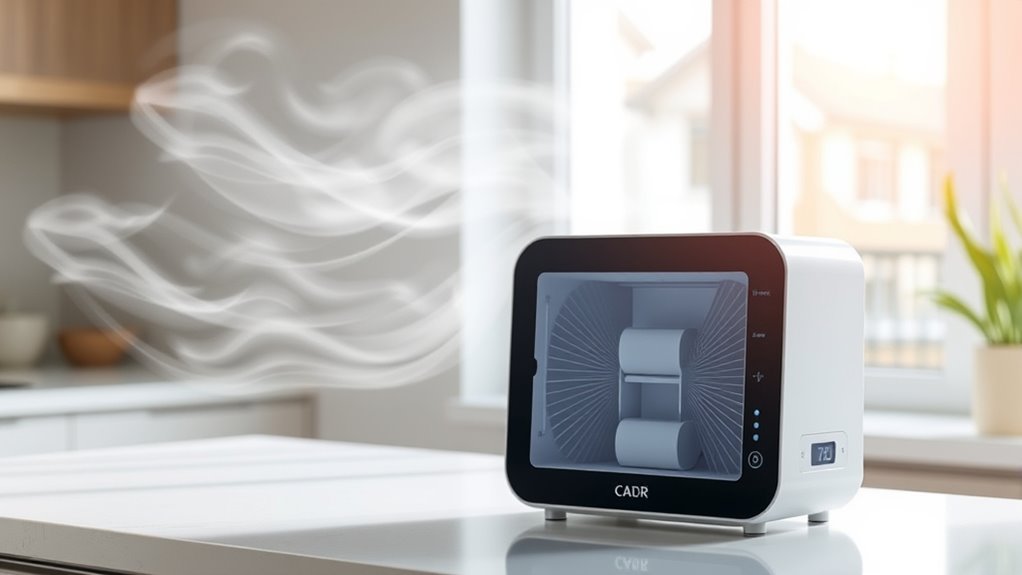
Ionizers and other advanced air purification technologies play a crucial role in enhancing indoor air quality by actively removing airborne contaminants. Air ionization works by releasing negative ions into the air, which attach to particles like dust, pollen, and smoke. These negatively charged particles become heavier and are pulled down or stick to surfaces, effectively clearing the air. Negative ions are naturally abundant in outdoor environments but are often reduced indoors, making ionizers a useful addition. By generating negative ions, ionizers help reduce allergens and improve overall air freshness. While they are effective at capturing tiny particles, it’s important to understand their limitations and combine them with other filtration methods for maximum results. Understanding this technology offers a chemical-free way to support cleaner indoor air. Additionally, the effectiveness of ionizers can be influenced by the air quality and environmental conditions within a space. Incorporating ionizers can also contribute to creating a more relaxing environment, which may enhance overall well-being. Furthermore, the presence of negative ions can help counteract indoor pollutants that contribute to airborne irritants, thus promoting a healthier living space.
Additional Features to Consider for Optimal Air Cleaning

What additional features should you look for to guarantee your air purifier delivers ideal cleaning performance? Air quality sensors are essential, as they monitor your environment in real-time, automatically adjusting settings for superior air purification. These sensors help you maintain healthy air without manual intervention. Smart connectivity is another valuable feature, enabling you to control your purifier remotely via smartphone apps or voice commands. This allows for scheduling, status updates, and customized settings, enhancing convenience and efficiency. Together, air quality sensors and smart connectivity ensure your purifier responds dynamically to your home’s needs, providing cleaner air with minimal effort. Incorporating AI-driven automation can further optimize performance by analyzing patterns and adjusting settings proactively, ensuring consistently high air quality. Additionally, integrating advanced filtration technologies can enhance the removal of pollutants and allergens, contributing to a healthier indoor environment. Moreover, choosing models with user-friendly interfaces can simplify operation and maintenance, making it easier to keep your air purifier functioning optimally. Using customizable modes can also help tailor the purification process to your specific needs, improving effectiveness. Being aware of necessary and functional cookies can also help you manage your device’s connectivity and updates more effectively, ensuring seamless operation. Prioritizing these features helps you achieve the best possible air quality and a healthier living space.
Making an Informed Choice: Matching Features to Your Needs
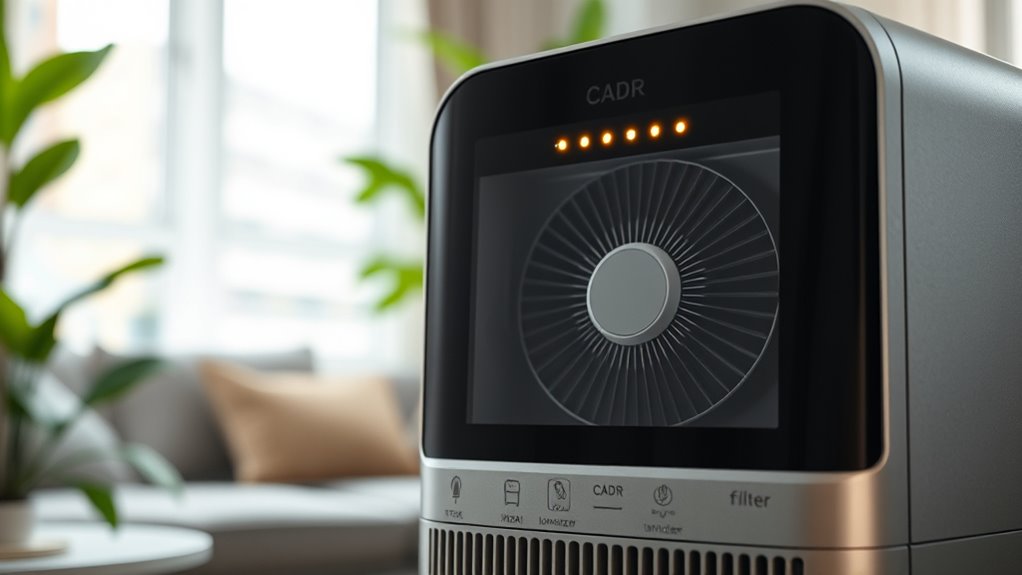
Choosing the right air purifier depends on understanding your specific needs and environment. Start by evaluating air quality indicators in your space—are you dealing with dust, allergens, or smoke? These indicators help determine which features matter most, like HEPA filters for allergens or activated carbon for odors. Consider filter maintenance requirements; some units need frequent filter changes, while others last longer. Matching these features to your environment ensures effective air cleaning without unnecessary upkeep. For example, if you have pets, look for models with allergen-specific filters and easy-to-replace components. By knowing your air quality indicators and understanding filter maintenance, you can select an air purifier that offers ideal performance suited to your needs, saving you time and ensuring cleaner, healthier air. Additionally, understanding the filter types and their respective functions can help you choose a unit that effectively targets your specific pollutants, especially in environments with specific pollutant sources like smoke or chemicals.
Frequently Asked Questions
How Do Noise Levels Vary Among Different Air Purifier Features?
You’ll notice noise level variations among different air purifier features, as each has feature-specific acoustics. For example, high fan speeds produce louder sounds, while quieter modes are ideal for bedrooms or offices. Ionizers tend to operate silently, but filters like HEPA or activated carbon may generate some noise during operation. To find the right balance, consider your comfort and environment, and check decibel ratings for precise noise level information.
Are There Health Risks Associated With Ionizer Use?
Oh, the irony of ionizer safety—thinking it’s all harmless air magic. In reality, ionizers can produce ozone, which might irritate your lungs and worsen asthma. While they help freshen your space, the health implications aren’t always obvious. You should weigh the benefits against potential risks, especially if you have respiratory issues. Always check the specific model’s ozone output to make certain you’re not trading clean air for health hazards.
How Often Should Filters and Ionizer Components Be Replaced?
You should check your air purifier’s filter maintenance and ionizer lifespan regularly, typically every 3 to 6 months. Replace filters when they become dirty or clogged to guarantee peak performance. Ionizer components often last around 1 to 2 years, but follow your device’s manual for specific guidance. Keeping up with these replacements helps maintain air quality and prevents potential health risks associated with outdated filters or worn-out ionizers.
Can Air Purifiers Effectively Remove All Types of Pollutants?
Imagine your air purifier as a vigilant guardian, battling invisible enemies. While it can effectively remove many pollutants like dust, pollen, and smoke, it doesn’t eliminate all toxins, especially gases or viruses. Its efficacy depends on the type of pollutants and the device’s features. So, you should know that an air purifier substantially improves air quality but isn’t a perfect shield against every airborne threat.
How Do Energy Consumption Rates Differ Between Features?
When comparing air purifier features, you’ll notice differences in energy efficiency and power consumption. Features like ionizers or higher CADR ratings often require more power, increasing energy use. However, models with smart sensors and adjustable settings can optimize performance while minimizing energy consumption. You should look for units with energy-efficient ratings to save on electricity bills, ensuring you get effective air cleaning without sacrificing power efficiency.
Conclusion
Choosing the right air purifier is like finding a trusty shield against airborne pollutants. By understanding features like HEPA filters, CADR, and ionizers, you can select the perfect fit for your space. Think of it as customizing your defense system—each feature works like a different layer of protection. With the right knowledge, you’ll breathe easier and enjoy cleaner air every day. Your ideal purifier is out there, ready to guard your home like a loyal guardian.
